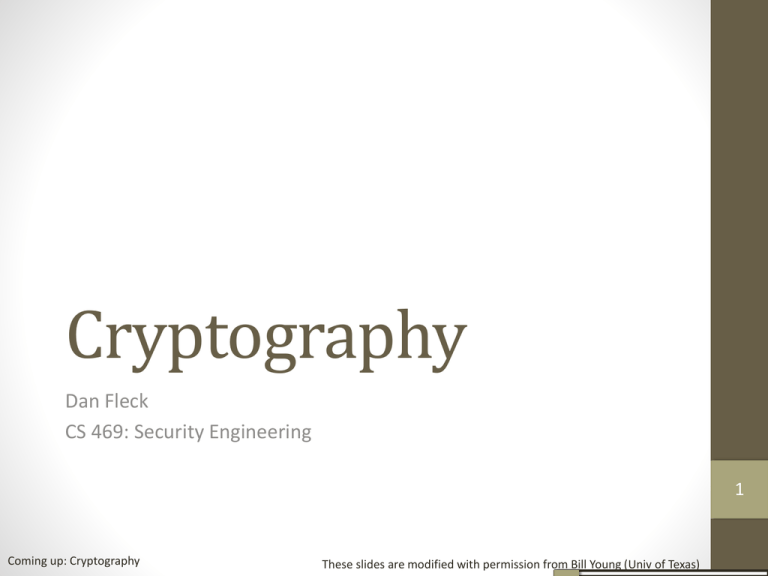Cryptography Dan Fleck CS 469: Security Engineering 1
advertisement

Cryptography
Dan Fleck
CS 469: Security Engineering
1
Coming up: Cryptography
These slides are modified with permission from Bill Young (Univ of Texas)
Cryptography
Apply your cryptanalytic skills.
How do you get started?
What questions should you ask?
• What is the likely underlying
language of the plaintext?
CIA Kryptos Sculpture
• What characteristics of the probable source text are relevant?
• What characteristics of the source language are relevant?
• What is the likely nature/complexity of the encryption
algorithm?
• Have any transformations/compressions been applied prior to
encryption?
• What else?
Coming up: Encryption / Decryption
2
Encryption / Decryption
The purpose of encryption is to render the message less useful /
meaningful to any eavesdropper. Conceptually, the process of
encryption is quite simple:
plaintext
Encrypt
ciphertext
Keye (optional)
As is the process of decryption:
ciphertext
Decrypt
plaintext
Keyd (optional)
3
Coming up: Information Theory and Cryptography
Information Theory and Cryptography
Information theory informs cryptography in several ways:
• What effect does encrypting a message have on the
information content of the file?
• An attempt to decrypt a message is really an attempt to
recover a message from a (systematically) noisy channel.
• How can redundancy in the source give clues to the decoding
process?
• Is a perfect encryption possible (i.e., one that is theoretically
unbreakable)?
4
Coming up: Some Terminology
Some Terminology
Encryption and decryption are functions which transform one
text into another. In functional notation:
C = E(P) and P = D(C)
where C denotes ciphertext, E is the encryption rule, D is the
decryption rule, P is the plaintext. In this case, we also have:
P = D(E(P))
It is obviously important to be able to recover the original
message from the ciphertext.
Coming up: Keyed Algorithms
5
Keyed Algorithms
Often the encryption and decryption algorithms use a key K. The key
selects a specific algorithm from the family of algorithms defined by E.
We write this dependence as:
C = E(P,KE ) and P = D(C,KD)
If KE = KD, then the algorithm is called symmetric. If not, then it is called
asymmetric. In general,
P = D(E(P,KE ),KD)
6
An algorithm that does not use a key is called a keyless cipher.
Coming up: Some Notation
Some Notation
Often the notation E(P,K) and D(C,K) becomes cumbersome. An
alternative notation is often used, particularly in cryptographic
protocols.
We’ll often use {P}K to denote E(P,K), and {P}K sometimes
E
D
to denote D(P,K). For example,
P = D(E(P, KE ), K D ) = {{P}KE }KD
This is usually appropriate since, in many important commercial
cryptosystems, the same algorithm is used for both encryption
and decryption (i.e., the algorithm is its own inverse).
7
Coming up: Cryptanalysis Tools
Cryptanalysis Tools
The analyst works with:
•
•
•
•
•
•
•
•
encrypted messages,
known encryption algorithms,
intercepted plaintext,
data items known or suspected to be in a ciphertext message,
mathematical and statistical tools and techniques,
properties of languages,
computers,
ingenuity and luck.
Really! CIA revealed that their analyst David Stein had
also solved the same sections in 1998, using pencil and
paper techniques, though at the time of his solution the
information was only disseminated within the
intelligence community, and no public announcement
was made. -Wikipedia
Coming up: Lessons
8
Lessons
• Encryption is designed to obscure the meaning of text.
• Redundancy is the enemy of secure encryption because it
provides leverage to the attacker.
9
End of presentation



